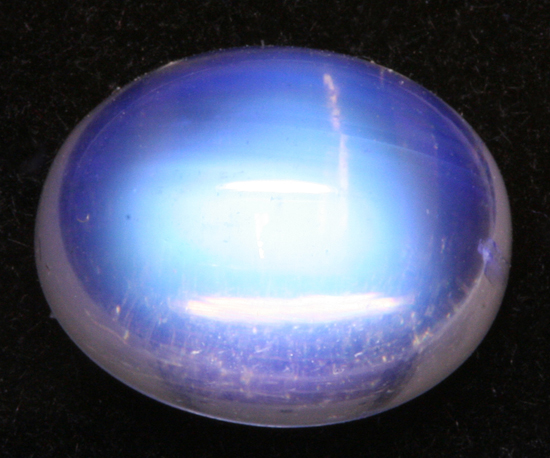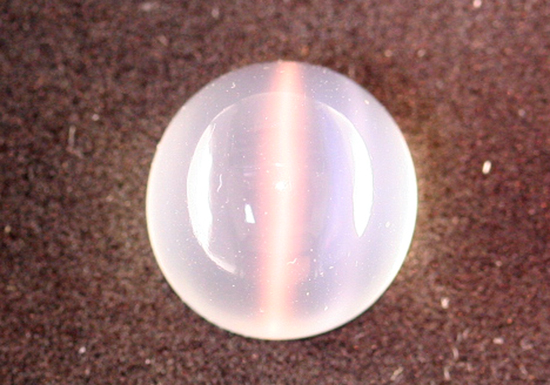Moonstone, a Gem that Magicks the Light
June 20th, 2009 by James L. Sweaney, CGA, FGA. GG
A Classic Ceylon Moonstone
Light has a very special role of gems- in diamonds, it can dance and twinkle, in rubies, it can simmer with vivid passion, or in other gems, it can play tricks. In gemology, we refer to these special gems that magic the light as the phenomenal gems.
The soft bluish glow emanating from this beautiful moonstone, a birthstone for June, is known as adularescence or schiller, an optical phenomenon in which light is scattered by structures within the gemstone. Thin transparent layers of two different types of feldspar, albite and orthoclase, alternate within the stone. Each layer type has slightly different optical properties, so light passing thru becomes a moving cloud, soft, diffused, and ever shifting. The schiller effect appears to follow the light, giving the impression of moonlight floating on water. Often the effect is white, but more rarely, we find blue, orange and rainbow lusters.
The name adularescence derives from the Adula Mountains of the Swiss Alps where moonstone was discovered. This type of moonstone, sometimes know as an adularia, is a variety of the mineral family feldspar. A number of other gems, including opal, rose quartz, and agate, may exhibit adularescence, but none have the brightness and beauty of the best moonstones.
The body color of moonstones varies from the transparency we see in the best Ceylon and Indian gems to white, golden, orange, gray, green and brown types with varying degrees of transparency. Generally, the more transparent the body color, the better the adularescence.
Other feldspar gems are the sunstone and the labradorite- these varieties exhibit their own special types of optical phenomenon. The best moonstones are usually from Ceylon, with other sources including Myanmar (Burma), India, and Madagascar.

Cat's Eye Moonstone
When the structures within the stone are aligned tightly parallel to each other, the glow can become focused by the lens shape of the cabochon into a band of light, a different optical phenomenon known as chatoyance or cat’s eye.
In this gem, the layers that create the eye cross the eye at 90 degrees. Other gem types that may exhibit the cat’s eye include the chrysoberyl, the tourmaline, the emerald, and the aquamarine- in fact, almost all the gem species have shown the cat’s eye at one time or another.
We see moonstones cut most often into soft rounded cabochon shapes that focus the light and bring out the optical magic. As designers, we love to work with the moonstone– it’s particularly suited to earrings and necklaces with its soft femine glow, but also makes absolutely fascinating rings. A lesser known birthstone for the month of June and the zodiac sign Cancer, the moonstone is exotic, spell binding, and reasonable in price.
Tags: Cat's Eye, Ceylon Moonstone, feldspar, Labradorite, sunstone







